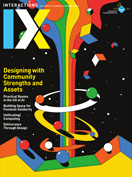Authors: Ashley Karr
Posted: Mon, August 12, 2013 - 11:43:00
Take away: Applying basic tenets of Positive Psychology during design evaluations can help teams cooperate and be more productive. This means that evaluators must discuss the positive aspects of the design at least as much as the negative.
A few months ago, I was speaking to a group about human factors (HF), human-computer interaction (HCI), and user experience (UX). To make my presentation more interactive, I asked the audience to evaluate an innovative new design. They responded immediately with a number of evaluations, but I soon noticed that all of their comments were negative. Their attention was on what was wrong, so I tried to shift their focus. I asked them to now evaluate positive aspects of the design. No one said a word. I was shocked.
This experience stayed with me. After the presentation, I kept wondering who had kidnapped the word evaluate and replaced it with criticize? I also wondered why it was so difficult for these educated, intelligent people to say something positive or constructive. Then, I came across a report by a pair of HF specialists from the design consulting firm, IDEO. The report was titled, “Are You Positive?” The authors, Aaron Sklar and David Gilmore, began the report by stating that many designers have operated under a disease model, essentially diagnosing the problems with a given design and making changes to mitigate risk and avoid damage. They then encouraged readers, especially those in the engineering and design fields, to take a positive approach to building and evaluating. Just imagine how well a team of hardworking engineers, designers, developers, and stakeholders would do if they made the design process itself human centered. Goal one is to develop a pleasurable experience for the user, and a good way to get there is to create a pleasurable team environment for the people creating the experience. Revolutionary indeed.
Sklar and Gilmore were inspired by a movement within psychology called Positivism. Positivism states that to reach a good psychological state, people should focus on what is good in their life and build on it, rather than focusing on and trying to fix or control what is bad. This is not to deny that bad things happen, in life or in design, and to be a responsible adult and professional, risk does have to be mitigated. This is simply to state that our default perspective ought to be a positive one. Here are three examples that Sklar and Gilmore gave on how to apply positivism to design right now:
- When asked to evaluate a design, try and create a longer list for positive aspects than for negative attributes.
- Create evaluation metrics for positive aspects of a design and share it with colleagues.
- Spend more resources (time, energy, money) on building new iterations than on breaking down old iterations.
I felt relief finding and reading Sklar and Gilmore’s report, knowing that a few more people in the world had gone through similar experiences as I had. I am happy to help them spread the word. Whether you are an engineer, a manager, a developer, a designer, a speaker, or just a person looking to live a better life, we can all take from Sklar, Gilmore, and Positivism. I challenge you, the reader, and me, the writer, to test this perspective for at least 24 hours—more if we can. Then notice what happens. What many have discovered is that creative ideas and solutions start flowing. I am certain we all can use more of this creative flow. So, test it out and get back to me on what you find. I would love to hear from you. You can send me an email or post your comment below.
Posted in: on Mon, August 12, 2013 - 11:43:00
Ashley Karr
View All Ashley Karr's Posts






Post Comment
@Adrian (2013 08 15)
Ashley, this is not only brilliantly written but it is quite frankly a tranquil breath of fresh air.
I deeply encourage the team at Interactions to invite Ashley to write more here.
@Simon (2014 01 13)
There is always something positive in an idea or a design. Sometimes something might be way off brief but even then it will still have some sort of merit. I have found it’s dangerous to stomp on creativity. Creatives and Designers will pull their head in & learn what an organization likes and stay within those confines to avoid being stomped on.